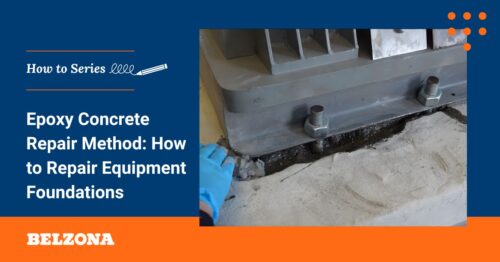If you’re looking for guidance on how to wrap pipes in damp, wet and underwater repair environments, this blog post will take you through all of the key steps needed to successfully install the Belzona SuperWrap II composite wrap solution.
This application process features Belzona 1984 – the latest addition to the collection of resins used in Belzona SuperWrap II composite wrap applications. Engineered specifically for surface tolerance, Belzona 1984 can be applied in aqueous environments without the need for abrasive blasting, making it the perfect solution for underwater pipe repair applications.

How to Wrap Pipes Underwater: A Step-By-Step Guide
Step One: Surface Preparation Prior to Application of Belzona SuperWrap II
For the first step in our How to Wrap Pipes Guide, brush away any loose contamination prior to roughening the surface. Then, use a suitable grinder to clean the surface to achieve the following standard of cleanliness: SSPC-SP11 power tool cleaning to bar metal and a minimum depth of profile 25µm (1 mil).

Step Two: Mixing the Epoxy Resin
Use the measuring cups provided to decant the Base (250 mL (8.5 US fluid oz) larger white cup) and Solidifier (150 mL (5.1 US fluid oz) smaller blue cup) in the correct volume ratio. Mix thoroughly in the bowl provided for three minutes until a homogenous mix is achieved.
Note: Cups should be filled to the brim to ensure correct mix ratio.

Step Three: Wetting Out the Composite Wrap
During pipe wrapping, ensuring the composite wrap is fully saturated with Belzona 1984 resin is key to achieving a durable repair. Apply the Belzona 1984 resin directly onto the Belzona 9381 composite wrap with an applicator, brush, roller, or rubber squeegee. Ensure saturation of Belzona 9381 fabric as indicated by the translucency of glass fibres on the composite fabric.
Note: In order to maximise product working life, avoid leaving rolled up wetted out composite to stand for prolonged periods.

Step Four: Wrap the Wet Pipe Repair Fabric
Within the marked pipe repair area, wrap the wet Belzona 9381 fabric helicoidally with a 50% overlap. Depending on the chosen Belzona 9381 fabric width, this may be indicated by a centre-line tracer stitch. Add additional wraps as required, observing over-wrap times. Regardless of conditions, no more than four wraps should be applied before the application of release film to ensure an effective bond.

Step Five: Wrap the Release Film
Wrap the perforated Belzona 9382 release film helicoidally over the completed wet pipe repair area. Apply tension to compress the composite.

Step Six: Secure at Both Ends
For the final step in our How to Wrap Pipes Guide, secure taut at both ends of the pipe wrap application.

Frequently Asked Questions
What is a composite wrap, and why is it used for pipe repair?
The Belzona SuperWrap II composite wrap is comprised of a 100% solids resin system, a bespoke hybrid reinforcement sheet, based on fibre glass and carbon fibre, as well as a release film to compact and consolidate the application. It is used for pipe repair to restore structural integrity, prevent leaks, and extend the lifespan of pipelines.
How do you repair a live leak in a pipe?
Repairing a live leak involves stopping the active flow of fluid temporarily and applying a suitable repair method, such as a composite wrap. For underwater or wet pipe repair, specialised systems such as Belzona SuperWrap II ensure a quick and effective solution.
What types of pipe damage can be repaired with a composite wrap?
Composite wraps are effective for repairing corrosion and erosion damage, cracks or holes, live leaks and damage caused by external impacts.
Learn More
How to Instantly Repair a Live Leak (with GIFs and Video)
3 Best Tips for Epoxy Pipe Repair
How to Apply Belzona 5871 Pipe Insulation Coating with Video
Video: Introduction to Belzona 1984
Want to Learn More About Belzona SuperWrap II?

Having joined Belzona in 2010, Ian Wade has cultivated a deep expertise in corrosion, coatings, and inspection services. Currently serving as the Technical Services Manager at Belzona’s headquarters in Harrogate, Ian has held various roles. These include Technical Services Engineer and Training Facility Team Leader, where he managed the day-to-day operations of the training facility and collaborated closely with technical and business development teams.
Ian’s professional journey has taken him across the UK and international waters, including stints in South Korea, China, the North Sea, and the Caspian Sea, performing both supervisory and hands-on inspection work. His practical experience extends to on-site applications using Graco spray pumps and hand-applied coatings, directly enhancing operational standards and safety.
Ian is an AMPP (NACE) Certified Coating Inspector Level 2 and is currently advancing his knowledge by pursuing a Bachelor of Engineering in Mechanical Engineering part-time at The Open University, expected to complete in 2027. He has written a number of technical articles including: Strengthening the Bond with Reliable Structural Adhesives and The Benefits of Protecting Storage Tanks with Sprayable, Polymeric Coatings. His commitment to technical excellence and his robust experience make him a valued leader and innovator in his field.



